By Lambert Strether of Corrente.
Bird Song of the Day
Spectacled Finch, Nar Gali, North-West Frontier, Pakistan. Got some points knocked off by purists for the highway noise, but what a performance!
Politics
“But what is government itself, but the greatest of all reflections on human nature?” –James Madison, Federalist 51
“Here’s food for thought, had Ahab time to think; but Ahab never thinks; he only feels, feels, feels.” –Herman Melville, Moby Dick
“So many of the social reactions that strike us as psychological are in fact a rational management of symbolic capital.” –Pierre Bourdieu, Classification Struggles
Biden Administration
“Biden’s Ending of the Covid Emergency Is a Public Health Disaster” [Gregg Gonsalves, The Nation]. So I’m not the only one. “[T]wo recent decisions—by a Democratic Congress and the Biden White House—represent harmful action rather than harmful inaction. Let’s start with the omnibus bill signed in December…. In 2020, Democrats and Republicans—yes, in bipartisan fashion—allowed people on Medicaid to continuously stay on the rolls until the public health emergencies that had been declared at the beginning of the pandemic were lifted. This was a momentous decision and a wise one. According to the Kaiser Family Foundation, ‘Total Medicaid/CHIP enrollment grew to 90.9 million in September 2022, an increase of 19.8 million or more than 27.9 percent from enrollment in February 2020.’ That represents close to a third of all Americans who were protected from losing their health insurance for the past three years. However, Senate majority leader Chuck Schumer, then-House Speaker Nancy Pelosi, and President Biden decided to do the inexplicable [No, it’s not] just in time for the holidays: They put a measure into the bill to delink the continuous enrollment provision in Medicaid from the public health emergency and end it as of March 31, 2023. According to Kaiser, ‘between 5 million and 14 million people will lose Medicaid coverage once the continuous enrollment provision ends.’ But the Democrats weren’t finished. On Monday, the White House announced that it will let the Covid-related public health emergency declarations expire on May 11, 2023… [T]he numbers don’t lie. As Alyssa Bilinski and Kathryn Thompson from the Brown School of Public Health, along with Ezekiel Emanuel from the University of Pennsylvania’s Perelman School of Medicine, wrote in a letter to the Journal of the American Medical Association in November: ‘The US continued to experience significantly higher Covid-19 and excess all-cause mortality compared with peer countries during 2021 and early 2022, a difference accounting for 150,000 to 470,000 deaths.’ Last week, more people died of Covid than perished in the Twin Towers on 9/11.” • Once you accept that the Democrat policy is mass infection without mitigation, these decisions are not “inexplicable” at all. They’re not bugs. They’re features. Features that make Pfizer very happy!
“What Ron Klain Learned in the White House” [The New Yorker]. That you can slaughter a million people without any political pushback? Kidding! Hagiography, but this little vignette: “The low point came in the fall of 2021, when progressives in the House withheld their support for a bipartisan infrastructure deal on the suspicion that moderates in the Senate would not follow through on a social-policy bill. The White House looked feckless, and, according to ‘The Fight of His Life,’ by Chris Whipple, a new book on Biden’s first two years, Klain thought of resigning. Instead, he turned, once more, to old relationships. [Ro] Khanna told me that Klain appealed to him for help, saying, ‘This has gone on long enough.’ Khanna agreed. ‘I said, ‘Ron, I’m going on ‘Face the Nation.’ I’m going to break from the progressive caucus and say I’m going to vote for the infrastructure bill.” Biden beseeched more liberals to support the bill, and prevailed; in November, 2021, he signed it into law in a ceremony on the South Lawn.” • The Freedom Caucus cut a much better deal for themselves, didn’t they?
2024
“Why DeSantis Is on Track to Beat Trump” [Jonathan Chait, New York Magazine]. “Unlike Trump’s 2016 opponents, who cycled through a series of unsuccessful attacks, DeSantis has also clearly prepared a winning contrast over Trump’s support for COVID-19 vaccines. Anti-vaccine sentiment has exploded on the right, and DeSantis has seized its leadership. ‘I think the blood-in-the-water knockout blow is the vaccines,’ former conservative radio host John Ziegler told Matthew Lewis, ‘because Trump is so deluded into believing that the vaccines — because he wants to take credit for them — were the greatest thing ever. That’s where, with way more than 50 percent of the Republican base, DeSantis can strike a knockout blow.’” • Maybe. But maybe not. If the issue is vaccine mandates, those were imposed by Biden.
“Nikki Haley, once Trump’s UN ambassador, to take him on in 2024” [Reuters]. “ormer South Carolina Governor Nikki Haley will kick off her campaign for the 2024 Republican presidential nomination this month, squaring off against her one-time boss, Donald Trump, two sources familiar with her plans said on Wednesday. The move would make her just the second declared Republican candidate and could set the stage for a more combative phase of the campaign, potentially putting her in the sights of the pugnacious former U.S. president. Haley’s campaign sent an email to supporters on Wednesday inviting them to a Feb. 15 event in Charleston. There she will declare her candidacy, the sources said. South Carolina is expected to host one of the first Republican nominating primaries in 2024 and will play an important role in picking the eventual candidate.” • So awesome. Clyburn muscled the Democrat primary to South Carolina, too! “South Carolina is too small for a republic, but too large for an insane asylum.” –James Louis Petigru of Charleston, South Carolina (1860).
“Inside the GOP’s “Save the kids” strategy” [Axios]. “The fractious Republican Party is consolidating around a ‘Protect the children’ platform for 2024 that aggressively targets school policies on gender identity and how racial issues are taught. A year before presidential primaries begin, Republicans see this as a winning formula that can fire up their base and attract some independents, pointing to the recent electoral success of Florida Gov. Ron DeSantis and Virginia Gov. Glenn Youngkin. Much of the battle is being fought at the state and local levels, giving an edge to GOP officials such as DeSantis and Youngkin — both potential presidential candidates who recognized the potency of educational issues early on.” • I dread 2024. I don’t think it’s going to be… fun. At all.
Democrats en Déshabillé
Patient readers, it seems that people are actually reading the back-dated post! But I have not updated it, and there are many updates. So I will have to do that. –lambert
I have moved my standing remarks on the Democrat Party (“the Democrat Party is a rotting corpse that can’t bury itself”) to a separate, back-dated post, to which I will periodically add material, summarizing the addition here in a “live” Water Cooler. (Hopefully, some Bourdieu.) It turns out that defining the Democrat Party is, in fact, a hard problem. I do think the paragraph that follows is on point all the way back to 2016, if not before:
The Democrat Party is the political expression of the class power of PMC, their base (lucidly explained by Thomas Frank in Listen, Liberal!). It follows that the Democrat Party is as “unreformable” as the PMC is unreformable; if the Democrat Party did not exist, the PMC would have to invent it. If the Democrat Party fails to govern, that’s because the PMC lacks the capability to govern. (“PMC” modulo “class expatriates,” of course.) Second, all the working parts of the Party reinforce each other. Leave aside characterizing the relationships between elements of the Party (ka-ching, but not entirely) those elements comprise a network — a Flex Net? An iron octagon? — of funders, vendors, apparatchiks, electeds, NGOs, and miscellaneous mercenaries, with assets in the press and the intelligence community.
Note, of course, that the class power of the PMC both expresses and is limited by other classes; oligarchs and American gentry (see ‘industrial model’ of Ferguson, Jorgensen, and Jie) and the working class spring to mind. Suck up, kick down.
RussiaGate
“The press versus the president, part one” [Jeff Gerth, Columbia Journalism Review] (and two, three, and four). • I’m still reeling from this. Within 24 hours after Mueller goes down in flames before Congress — and the very expectant press — Trump picks up the phone and makes a call to get dirt on Joe Biden* — from a CIA asset: Volodymyr Zelenskyy. I’m sure the Big Z couldn’t believe his good luck, and immediately sold Trump to his handlers. In so many ways, Trump comes across as… well, as a little child. An innocent in a world of malevolent grownups (which, given Fred, was certainly true, at least for a short time in Trump’s life). If you have the time to sit down with this, it’s really worth it, just to get the incredibly grotty timeline straight. NOTE * I am not, of course, implying that there is no dirt on Joe Biden.
Realignment and Legitimacy
Jimmy Dore on Tucker Carlson:
Good for him. Do it, say I.
“Can we please distinguish between antiwar and just war politics?” [Carl Beijer]. “Here, I’d like to just make a basic definitional point: just war arguments are not antiwar arguments. I don’t understand how anyone could object to this, first because it’s just logically true because of what “anti” means, and second because just about everyone believes in some version of just war theory. If we can just agree to use these words consistently, maybe the discourse on Ukraine will become at least marginally less ridiculous. The fact that both sides are leaning so heavily on nearly identical arguments — “it isn’t war if you’re fighting in self-defense” — should be a big red flag no matter which side you’re on, because it reminds us how easily this war-is-peace rhetoric can be abused. I don’t think that the case for war is even remotely defensible here, but if you’re going to make it, own it.”
“We’re Ruled By [glass bowls] Because We Have [glass bowl] Systems: Notes From The Edge Of The Narrative Matrix” [Caitlin’s Newsletter]. Quoted text not necessarily safe for work: “People have a fairly easy time accepting that things are fucked because we are ruled by corrupt assholes. They have a much harder time accepting that we are ruled by corrupt assholes because our corrupt asshole systems will always necessarily elevate corrupt assholes to the top. It’s easier to blame our problems on oligarchs or the Deep State or a cabal of satanic pedophiles than it is to blame them on systems that we ourselves participate in and have lived our entire lives intertwined with and which have been continuously normalized within our culture. If the problem is just a few corrupt assholes then it’s not a very daunting problem, because all you have to do is remove those corrupt assholes and everything’s golden. If the problem is the systems around which our entire civilization is structured, it’s far more daunting. It’s easy to imagine a future without corrupt assholes. It’s almost impossible to imagine a future where human behavior is not driven by profit for its own sake, where we have moved from competition-based systems to collaboration-based ones where we all work together for the common good.” • Hence, the destruction of public health and, in fact, the very notion of a “public” (but maybe it was time for that?)
“What’s the Matter with Men?” (review) [The New Yorker]. Richard V. Reeves, Of Boys and Men: Why the Modern Male Is Struggling, Why It Matters, and What to Do About It. Quick summary: “[T]he rapid liberation of women and the labor-market shift toward brains and away from brawn have left men bereft of what the sociologist David Morgan calls ‘ontological security.’ They now confront the prospect of ‘cultural redundancy,’ Reeves writes. He sees telltale signs in the way that boys are floundering at school and men are leaving work and failing to perform their paternal obligations. All this, he says, has landed hardest on Black men, whose life prospects have been decimated by decades of mass incarceration, and on men without college degrees, whose wages have fallen in real terms, whose life expectancies have dropped markedly, and whose families are fracturing at astonishing rates. Things have become so bad, so quickly, that emergency social repairs are needed. ‘It is like the needles on a magnetic compass reversing their polarity,’ Reeves writes. ‘Suddenly, working for gender equality means focusing on boys rather than girls.’” • Anybody who thinks that being a member of the PMC is about “brains” is a very particular kind of fool. I know; these are my people!
#COVID19
Lambert here: I am but a humble tapewatcher, but unlike Eric Topol, I’m not calling a surge, because the last peak was Biden’s Omicron debacle, and after an Everest like that, what’s left? Topol’s view is the establishment view: Hospital-centric. Mine is infection-centric. I do not see the universal acceleration or doubling in cases that I would expect to see based on past surges.
I am calling a “Something Awful.” It’s gonna be bad, in some new way, and we don’t know how, yet (but see here for immune system dysregulation, which is looking pretty awful).
Lambert here: Looks like “leveling off to a high plateau” across the board. Stay safe out there!
• “China Covid: Coffins sell out as rural losses mount” [BBC]. “There has been much debate about the real number of Covid deaths in China, after the virus ripped through its megacities. Some 80% of the population – more than a billion people – have been infected since China scrapped restrictions in December, according to leading epidemiologist Wu Zunyou. Last weekend China reported 13,000 Covid-related deaths in less than a week, adding to the 60,000 deaths it has counted since December. But these deaths have been in hospitals. In rural areas there are only sparse medical facilities and those who die at home are mostly not being counted. There is not even an official estimate for the number of village deaths. But the BBC found evidence the death toll is mounting. We visited a crematorium and they too have been busy, mourners dressed in white walking forward carrying the ceremonial box which would eventually contain the remains of a loved one. In another village, we saw one man and woman loading huge tissue paper birds onto the back of a flatbed truck. ‘They’re cranes. You ride the crane into the afterlife,’ the woman said. As they packed up other elaborate, Buddhist images newly made from tissue paper they said they’d had an explosion in demand for their funeral decorations, two or three times what’s normal. Everyone we met in this part of Shanxi who is connected to the funeral industry told us a similar story about an increase in deaths and they all attributed it to the coronavirus.” • We need better proxies. But… No estimate for rural deaths? Really?
• “Commercialization of COVID-19 Vaccines, Treatments, and Tests: Implications for Access and Coverage” [Kaiser Health News]. • Here we go:
While each of these two changes – the depletion of the federal supply and end of the PHE – matters on its own, their interaction also matters and may amplify access challenges.
- The extent of these challenges varies by product and is most acute for treatments and tests. While COVID-19 vaccines, including boosters, will continue to be available for free to virtually all those with public and private insurance even when there is no longer any federally-purchased supply remaining or PHE protections in place, this will not be the case for COVID-19 treatments and tests, where cost sharing will be widely permitted.
- These access challenges will also vary by payer, with the uninsured and the underinsured standing to lose the most. Whereas these products will continue to be covered by both public and private insurance after the federal supply is depleted and the PHE protection period is over, albeit in some cases with cost sharing, this is not the case for adults who are uninsured, who will have limited access to free vaccines, and no coverage for the cost of treatments and tests.
- Finally, even if consumers are still guaranteed free access or protected against some costs, they could face access challenges if sufficient supplies are not available from manufacturers or procured by pharmacies or other providers.
“Cost sharing.” What a euphemism.
“Could a popular COVID-19 antiviral supercharge the pandemic?” [Science]. Yes, actually. Molnupiravir: “A widely used COVID-19 drug may be driving the appearance of new SARS-CoV-2 variants, sparking concerns it could prolong and even reinvigorate the pandemic. The drug, molnupiravir, produced by Merck & Co., is designed to kill the virus by inducing mutations in the viral genome. A survey of viral genomes reported in a new preprint, however, suggests some people treated with the drug generate novel viruses that not only remain viable, but spread.” • That preprint in Links, 12/23/2022. Now it’s in Science….
• “House bill seeks to end CMS’ COVID-19 vaccine rule for healthcare facilities” [Becker’s Hospital Review]. • Not a “rule.” A mandate. Quite a difference.
• I agree with this:
My hot take is that most of us have not adequately processed the trauma of the pandemic. And our sprawling, unprocessed trauma chews away at our brains in myriad ways that make us anxious about why we can’t seem to live our lives as instinctively or as joyously as we did in 2019.
— Jeremy, Mental Health Street Fighter (@JeremyWingert79) January 28, 2023
I personally dodged many a bullet, I would like to believe protected by my protocol, but I know others who were not so lucky. It’s very hard for me to believe that a million people can die — especially elders, whose death necessarily effects generations — with no society-wide expression of grief. There was an AIDS quilt — 54 tons worth of it — and a National AIDS memorial. Why no equivalent for a much larger, society-wide, culling event? I can only think that there must an enormous quantum of “stuffed” emotion surrounding the pandemic, some perhaps displaced onto rage (blaming masks, for example), but most unexpressed. Very strange.
• Maskstravaganza: Useful timeline:
• A good tip on overhead vent hoods:
I certainly don’t have a good mental model of how air circulates in a confined space like a bagel shop. Would be useful!
Case Data
NOT UPDATED BioBot wastewater data from January 30:
For now, I’m going to use this national wastewater data as the best proxy for case data (ignoring the clinical case data portion of this chart, which in my view “goes bad” after March 2022, for reasons as yet unexplained). At least we can spot trends, and compare current levels to equivalent past levels.
Transmission
Here is CDC’s interactive map by county set to community transmission (the “red map,” which is the map CDC wants only hospitals to look at, not you.) The map is said to update Monday-Friday by 8 pm:
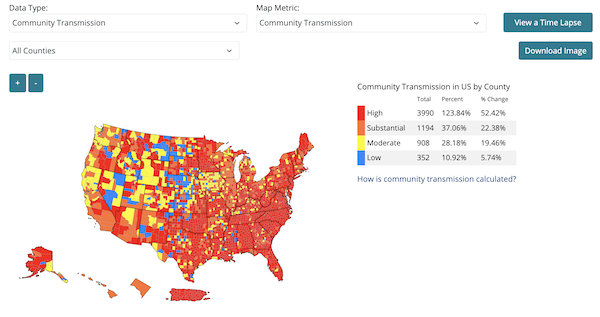
The previous map:
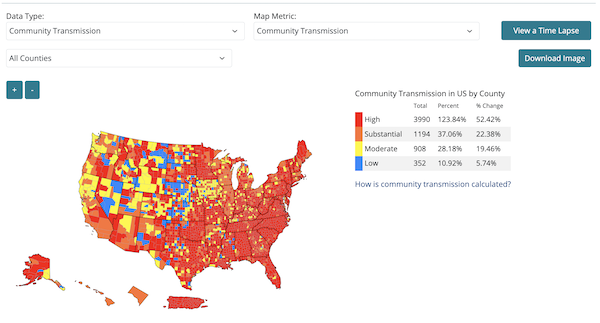
NOTE: I shall most certainly not be using the CDC’s new “Community Level” metric. Because CDC has combined a leading indicator (cases) with a lagging one (hospitalization) their new metric is a poor warning sign of a surge, and a poor way to assess personal risk. In addition, Covid is a disease you don’t want to get. Even if you are not hospitalized, you can suffer from Long Covid, vascular issues, and neurological issues. That the “green map” (which Topol calls a “capitulation” and a “deception”) is still up and being taken seriously verges on the criminal.
Positivity
From the Walgreen’s test positivity tracker, published February 2:
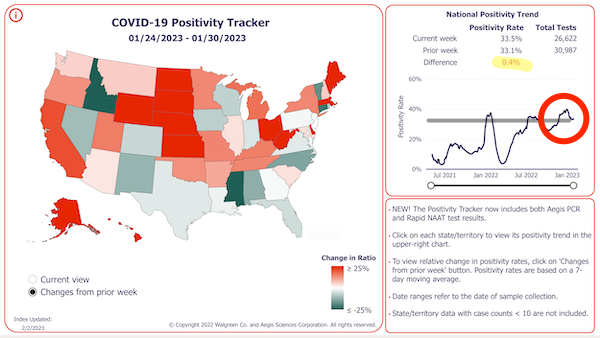
0.4%. Slight increase (still at a high plateau).
Wastewater
Wastewater data (CDC), January 29:
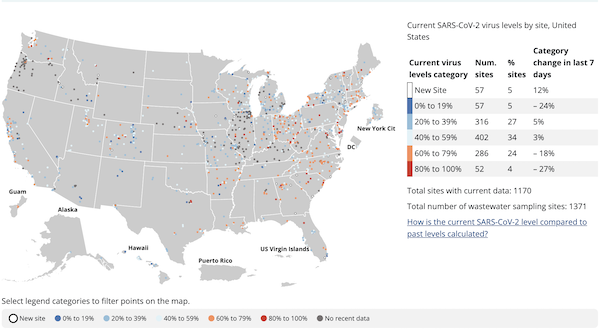
Again, what the [family blog] is the [family blogging] use of a national wastewater map where nearly all the collection sites are [family blogging] greyed out?
January 28:
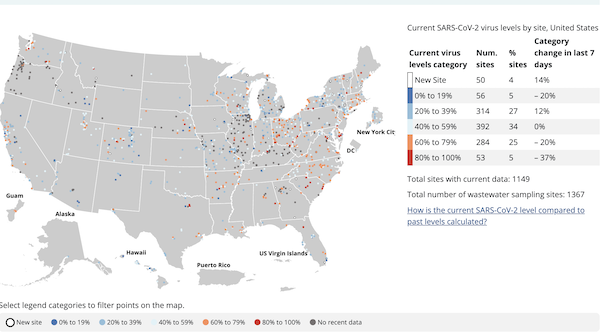
And MWRA data, January 30:
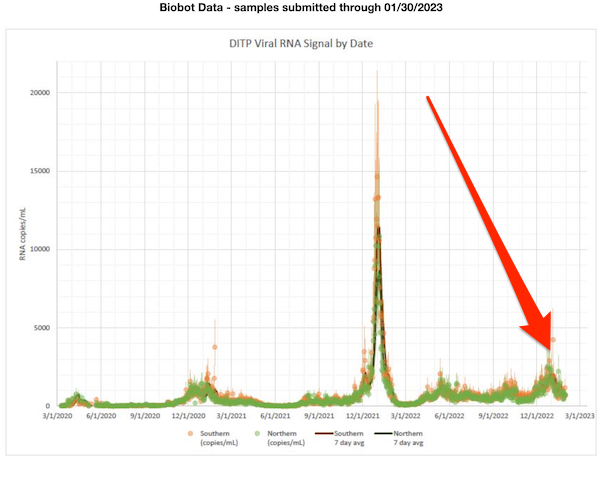
Looks to me like New England’s regional surge is winding down. No bump from the students returning. Readers?
Variants
Lambert here: It’s beyond frustrating how slow the variant data is. Does nobody in the public health establishment get a promotion for tracking variants? Are there no grants? Is there a single lab that does this work, and everybody gets the results from them? [grinds teeth, bangs head on desk]. UPDATE Yes. See NC here on Pango. Every Friday, a stately, academic pace utterly incompatible with protecting yourself against a variant exhibiting doubling behavior.
Variant data, national (Walgreens), January 23:
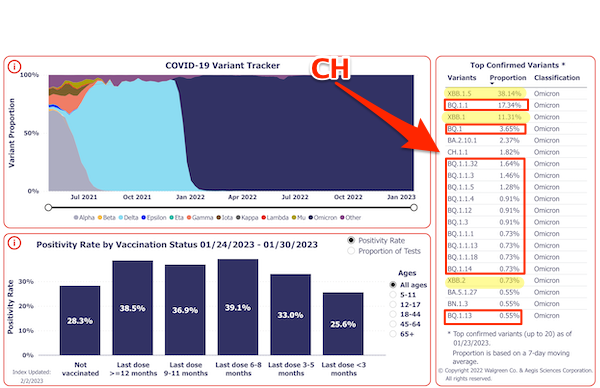
Lambert here: XBB overtakes BQ. CH not moving too fast, reassuring, because a Tweet in Links, January 11 from GM drew attention to it (“displays such a high relative growth advantage”) and in Water Cooler, January 18, from Nature: “CH.1.1 and CA.3.1 variants were highly resistant to both monovalent and bivalent mRNA vaccinations.”
Lambert here: Wierdly, the screen shot about has been replaced today by data from “10/7/2022.” (It’s clearly not current data; BQ.1* and XBB do not dominate.
NOT UPDATED Variant data, national (CDC), January 7 (Weighted Estimates Only*):
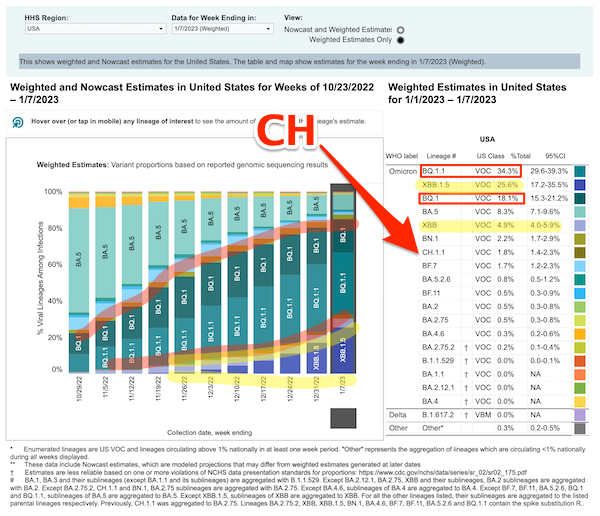
BQ.1* takes first place. XBB coming up fast. (For BQ.1/XBB and vaccine escape, see here.) CH.* now appears, a week after Walgreens. Here is Region 2, the Northeast:
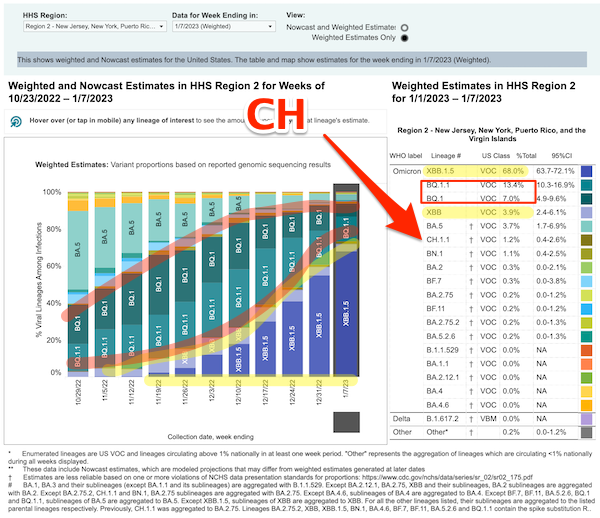
CH.1* appears, but slightly below the national average. XBB utterly dominates, making clear that Region 2 (New England) varies greatly from the national average. Wouldn’t it be interesting if we ended up with different variants dominating different parts of the country.
NOTE * CDC used to have a “Nowcast Off” radio button, which I used because of my bad experience with CDC models like Nowcast. CDC explains (I think) the change in the following note:
Weighted estimates (provided for all weeks except the most recent three weeks) are variant proportions that are based on empirical (observed) genomic sequencing data. These estimates are not available for the most recent weeks because of the time it takes to generate the unweighted data, including sample collection, specimen treatment, shipping, analysis, and upload into public databases.
Sublineages with weighted estimates less than 1% of all circulating variants are combined with their parent lineage. When the weighted estimate of a sublineage crosses the 1% threshold and has substitutions in the spike protein that could affect vaccine efficacy, transmission, or severity, it may be separated from its parent lineage and displayed on its own in the variant proportions data.
Nowcast estimates (provided for the most recent three weeks when the “Nowcast on” option is selected below) are model-based projections of variant proportions for the most recent weeks to enable timely public health action. CDC uses the Nowcast to forecast variant proportions before the weighted estimates are available for a given week.
Someone who can interpret The Great Runes can look at this; but I don’t have time today.
As a check, since New York is a BQ.1* hotbed, New York hospitalization, updated February 1:
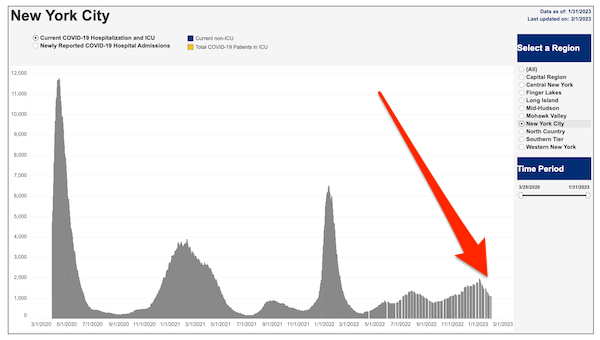
Not as high as Biden’s ginormous jouissance, but still high.
Hospitalization data for Queens, updated January 29:
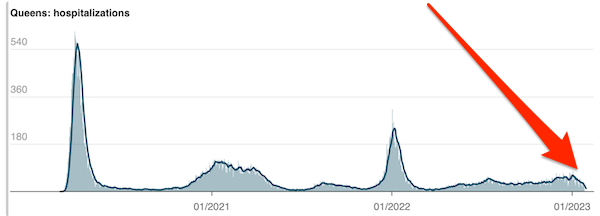
Deaths
Death rate (Our World in Data):
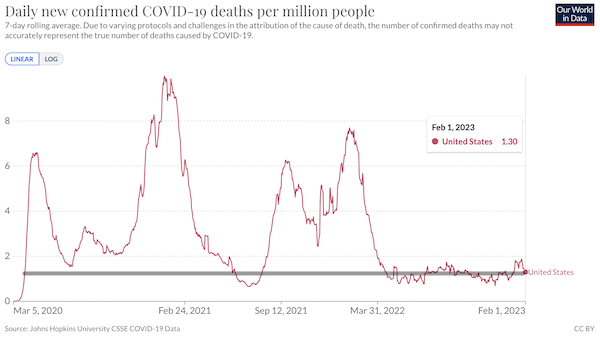
Total: 1,134,259 – 1,132,935 = 1324 (1324 * 365 = 483,260 deaths per year, today’s YouGenicist™ number for “living with” Covid (quite a bit higher than the minimizers would like, though they can talk themselves into anything. If the YouGenicist™ metric keeps chugging along like this, I may just have to decide this is what the powers-that-be consider “mission accomplished” for this particular tranche of death and disease).
It’s nice that for deaths I have a simple, daily chart that just keeps chugging along, unlike everything else CDC and the White House are screwing up or letting go dark, good job. (Though CDC may be jiggering the numbers soon. Lower, naturally.)
• “More Californians Are Dying at Home. Another Covid ‘New Normal’?” [Kaiser Health News]. “The covid-19 pandemic has spurred a surge in the proportion of Californians who are dying at home rather than in a hospital or nursing home, accelerating a slow but steady rise that dates back at least two decades…. ‘Whenever I ask, ‘Where do you want to be when you breathe your last breath? Or when your heart beats its last beat?’ no one ever says, ‘Oh, I want to be in the ICU,’ or ‘Oh, I want to be in the hospital,’ or ‘I want to be in a skilled nursing facility.’ They all say, ‘I want to be at home,” said John Tastad, coordinator for the advance care planning program at Sharp HealthCare in San Diego.” • So, good!
Stats Watch
There are no official stats of interest today.
Retail: “The Junkification of Amazon” [New York Magazine]. The deck: “Why does it feel like the company is making itself worse?” • Because it is.
Advertising: “Fame: Brands wanna live forever” [Bob Hoffmann, Campaign]. “If it is true that all we have are likelihoods and probabilities, we should ask ourselves what the single outcome of advertising is that is most likely to result in business success? I believe the answer is obvious. Fame. All of the world’s hugely successful brands have one common characteristic. They are famous. A brand that is famous has enormous advantages over its competitors that are not famous. Traditional marketers and advertisers will often assert that differentiation or positioning or ‘brand meaning’ are the key advertising drivers of brand success. I’ve heard them say that fame without ‘a reason’ is empty and worthless. They say that positioning or differentiation are the first job of advertising because they give substance to fame. In other words, positioning and differentiation are the factors that make fame productive. I think this is wrong. In fact, I think it’s exactly the opposite. I think that fame, by itself, inherently creates the strongest type of positioning and differentiation. The most powerful differentiator for any brand is being the most famous in its category. The most powerful position for any brand is being the most famous in its category. Fame has many positive but not necessarily logical associations. These include trust, social acceptance, and credibility. Any brand can try to differentiate or position itself by claiming to engender ‘trust, acceptance, and credibility.’ But only fame has the unique ability to communicate these attributes without having to say them.” • Hmm.
Tech: “The Billions-Dollar VR/AR Headset Question” [Daring Fireball]. “The appeal and utility of all-day [Augmented Reality (AR)] glasses is obvious. But we are obviously very far away from such devices being possible, at any price. And I don’t think such devices will ever be goggles with a screen, using cameras to show the real world. I think they must be see-through lenses that somehow include display technology that can project opaque objects and virtual ‘screens’ within your field of vision. I am convinced we will get there. I am equally convinced we are not close to being able to make such devices…. My strong gut feeling is that mass-market all-day AR glasses won’t be feasible until 15 or so years after the first sensational VR goggles. They’ll require that much of, and that many, generational leaps forward: chip miniaturization, battery tech, display tech, and sensor tech.” • That’s a long time to wait…
Today’s Fear & Greed Index: 73 Greed (previous close: 73 Greed) [CNN]. One week ago: 68 (Greed). (0 is Extreme Fear; 100 is Extreme Greed). Last updated Feb 2 at 2:08 PM EST.
Photo Book
Black and white (1):
f64 no doubt… Sharp all the way back to the mountains!
Black and white (2):
Under the Influence
This is like one of those Onion headlines where you don’t even have to read the story. One tweet will do:
The 420
“High Anxiety” [Spotlight PA]. “Anxiety disorders are now the leading reason Pennsylvanians get a medical marijuana card, a first-of-its-kind analysis of more than 1.1 million certification records obtained by Spotlight PA reveals… The Department of Health’s rules and enforcement give those physicians great leeway in deciding whether to issue certifications. The department adopted regulations that require medical marijuana doctors to review available health care records, but those rules do not spell out how providers should determine if records exist. The department has also stated that patients might not have records for certain conditions and certifying doctors may be the ones ‘making the initial diagnosis.’ Some medical marijuana card companies actively court clients who lack a prior diagnosis or medical records showing they have an anxiety disorder.” • The contrast to the free pass given to oxycontin is pretty obvious. Then again, what on earth is there it be anxious about? What’s wrong with these people?
Health Care
“Incorrectly recorded anesthesia start times cost medical centers and anesthesia practices significant revenue” (press release) [American Society of Anesthesiologists]. n= 40,312. “Inaccurately recording the start of anesthesia care during a procedure is common and results in significant lost billing time for anesthesia practices and medical centers, suggests a study being presented at the American Society of Anesthesiologists’ ADVANCE 2023, the Anesthesiology Business Event. The anesthesia start time (AST) must be documented from a computer logged into the electronic health record (EHR), and typically occurs once the patient is in the operating room (OR). However, the anesthesiologist meets with the patient prior to their arrival in the OR and begins tasks that are vital to the procedure — such as administering pre-medication and attaching monitors — and that time typically is not recorded. Depending on the patient and procedure, adding two to five minutes to the AST when logging it would account for the preparation and transit time, researchers say. ‘These seemingly minor inaccuracies of recorded AST can cost medical centers and anesthesia practices hundreds of thousands of dollars in lost revenue,’ said Nicholas Volpe Jr., M.D., MBA, lead author of the study and an anesthesiology resident physician at Northwestern University McGaw Medical Center, Chicago. ‘We suspect most anesthesiologists are unaware that they aren’t recording AST accurately. It’s not a result of negligence, but rather reflects that workflow hasn’t been optimized for accuracy.’” • Good to see our M.D.s focusing on what really counts!
Zeitgeist Watch
“Relatable: Marie Kondo Gives Up” [Gizmodo]. “‘Up until now, I was a professional tidier, so I did my best to keep my home tidy at all times,’ [Kondo] said via interpreter in a recent media webinar, as reported by the Washington Post. More recently though, ‘I have kind of given up on that,; she noted. And declared, ‘my home is messy,’ in no uncertain terms. Kondo gave birth to her third child in 2021, and has seemingly been re-evaluating her priorities since. She said she’s abandoned peak organization ‘in a good way.’ Instead of dedicating endless hours to ensuring her home is perfectly put together, ‘Now I realize what is important to me is enjoying spending time with my children at home.’ To her, focusing on family over folding is time spent ‘the right way for me at this time, at this stage of my life.’ To which Gizmodo says: good for her! She may have built an organizational empire off of books, TV shows, brand partnerships, and home goods all essentially bearing the message of ‘get yourself together,’ but everyone deserves a break from the unending work of categorizing life’s clutter. Plus, if Marie Kondo isn’t even KonMari-ing, maybe that means the rest of us are free to stew in our slop.” • Yay!
“The Dirt on Pig-Pen” [Astra]. From the Peanuts cartoon strip: “There is something hard to pin down in Pig-Pen’s condition. The nature, even the physical behavior of Pig-Pen’s dirt fluctuates. From one week to another, it is likened to chalk powder (as when he ‘washes’ his hands by beating them together, ‘the way they clean erasers’), to sand (you could put ‘four boards around that kid and have an ‘instant sandbox”), to soil, mud, and dust. He is described as being ‘cooled by several layers of clay’ (protecting him from heat), or blending in with the dirt at second base. He is associated with bacteria, carrying his Easter jelly beans around so long that they start to ‘ferment.’ Violet describes him as a ‘germ carrier.’ Pig-Pen seems offended, but declares that even germs need a rest. The physical dirt itself: Is it organic or inorganic? Does it come off? Does Pig-Pen want it to? Pig-Pen first appears in 1954. Violet’s judgmental friend, Patty, sees him playing in the sand and asks his name. Pig-Pen replies that he doesn’t have one; people just call him ‘insulting things.’ Patty asks for specifics. ‘I’ll tell you if you won’t laugh,’ Pig-Pen says. His name is a punch line. For a long time, Pig-Pen’s name consistently appears in quotation marks, reminding us that it isn’t really a name — that he has, presumably, another one that he doesn’t know.”
Black Injustice Tipping Point
“Low Resolution History” [London Review of Books]. “One of the most revealing things about discussion of The Woman King has been how low-resolution popular knowledge of African history remains. Half a century after the Regius Professor of Modern History at Oxford declared that there was no African history to teach, only the ‘history of Europeans in Africa’, many in the West would still fail to name a single pre-colonial African kingdom if asked. The Woman King represents a step forward in general awareness, but it’s in a cultural climate where discussions of Africa cannot take any pre-existing knowledge for granted. For many, the image of pre-colonial West Africa remains one of undefined ‘tribes’ and men with spears. Discourse about ‘Africans selling Africans’ is also common, but slaves were most frequently captured in inter-state conflicts, by people who saw them as categorically different. This was a time before Pan-Africanism was even a twinkle in Kwame Nkrumah’s eye. And attitudes differed among those in power: Ghezo’s commitment to ending the trade was shaky but, as Walter Rodney noted in How Europe Underdeveloped Africa, one of his Dahomey predecessors, Agaja Trudo, actively raided and looted European forts and slave camps on the coast. All this nuance is lost in the widening gyre of contemporary political imperatives, and no Hollywood movie can reasonably be expected to act as a microcosm of an entire historical era, let alone an already underrepresented one.”
Class Warfare
“The difference between ‘rich’ and ‘wealthy,’ according to New York Times ‘Wealth Matters’ columnist” [CNBC]. “To the frustration of some of his readers, [Paul] Sullivan came to define wealth not as a dollar figure but in terms of what your savings allow you to do. ‘The people that I consider wealthy — whether you’re a schoolteacher or a billionaire — are the people who, when they want to do X, they can do it,’ he says. He pointed to billionaire businessman Jon Huntsman, whose corporation invented, among other things, the plastic clamshell containers that Big Macs used to come in, as well as to his own aunt, a retired schoolteacher whose savings allow her to buy whatever she wants for herself and to travel to visit family whenever she pleases. On the rich-but-not-wealthy side of the equation, Sullivan says you’re likely to find plenty of hedge fund managers. ‘They make a ton of money, but they may also be highly leveraged,’ he says, meaning that much of their money on paper may come from investing borrowed money. Lack of control over their own financial decision-making is a key indicator that they’re not, in fact, wealthy, he adds: ‘Life is going to make choices for them.’” “Life” doesn’t “make choices” for working class people? All of them, without exception? In a way that “life” does not “make choices” for, say, Trustafarians?
“Tech layoffs strip the facade off TikTok’s ‘day in the life’ videos” [NBC]. The deck: “Creators pivot to content about unemployment and labor rights instead of aspirational videos of corporate perks.” • Wow, TikTok permits that?
News of the Wired
“A city-wide examination of fine-grained human emotions through social media analysis” [PLOS One]. “In this study, we expand upon the previous research domain and utilize data from the social media platform Twitter to analyze fine-grained human emotions at a city wide level. Different approaches for automatically detecting fine-grained human emotions from the social media platform Twitter were examined and evaluated. Afterwards, Neural Network classifiers were used to identify emotions from geotagged tweets in two cities, San Francisco and London and data from Open Street Map data was used to spatially contextualize the social media information….. [W]e examined seven different fine-grained emotions (Anger, Anticipation, Disgust, Fear, Trust, Joy and Sadness) at a city-wide level based on large-scale data analysis from social media… The results showed significant differences with regard to the type of place, such as how tweets in London showed significantly more Anger at Transportation and Sport locations than at Education, and Residential locations and how tweets which display Anger and Sadness in SF tend to have significantly higher numbers of Office venues in the nearby vicinity.” • Interesting, actually!
“The science behind seasonal depression” [Scientific American]. “As much as three percent of the general population is thought to experience SAD, but one study Rosenthal published in 1990 found that the condition became more prevalent in the U.S. in northern latitudes, with as many as 10 percent of New Hampshire residents reporting the condition.” • Not all studies agree, and there are many confounders. That said, I believe SAD is real, and I also believe it has to do with change in available light, i.e., you can get it moving away from the solstice as well as towards it. My advice, as usual, is to walk outside in the daylight, and look up at the sky and the trees, not down at your feet. One day the buds on the tree branches will appear!
Contact information for plants: Readers, feel free to contact me at lambert [UNDERSCORE] strether [DOT] corrente [AT] yahoo [DOT] com, to (a) find out how to send me a check if you are allergic to PayPal and (b) to find out how to send me images of plants. Vegetables are fine! Fungi and coral are deemed to be honorary plants! If you want your handle to appear as a credit, please place it at the start of your mail in parentheses: (thus). Otherwise, I will anonymize by using your initials. See the previous Water Cooler (with plant) here. From marku52:

marku52 writes: “Red Hot Pokers this fall in SW OR.”
Readers: Water Cooler is a standalone entity not covered by the annual NC fundraiser. So if you see a link you especially like, or an item you wouldn’t see anywhere else, please do not hesitate to express your appreciation in tangible form. Remember, a tip jar is for tipping! Regular positive feedback both makes me feel good and lets me know I’m on the right track with coverage. When I get no donations for five or ten days I get worried. More tangibly, a constant trickle of donations helps me with expenses, and I factor in that trickle when setting fundraising goals:
Here is the screen that will appear, which I have helpfully annotated:

If you hate PayPal, you can email me at lambert [UNDERSCORE] strether [DOT] corrente [AT] yahoo [DOT] com, and I will give you directions on how to send a check. Thank you!


